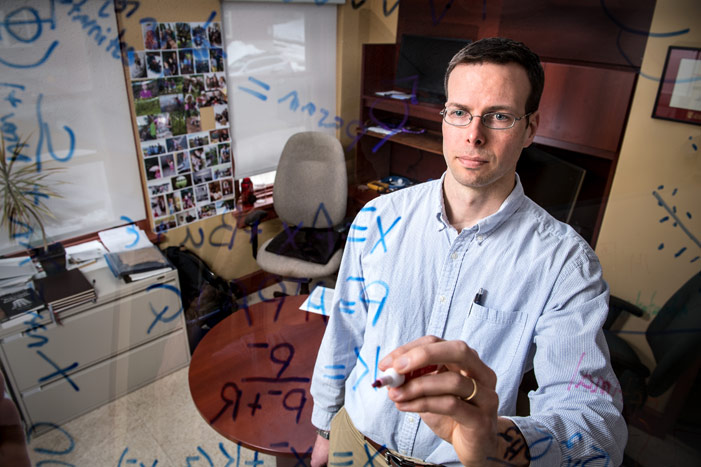Researchers uncover breakthrough in connecting mind to machine restoring sense for people with prosthetic arms
Author: UNB Newsroom
Posted on Mar 14, 2018
Category: UNB Fredericton

A bionics researcher with the University of New Brunswick is part of a team that has discovered a pioneering technique to restore natural movement sensation in patients with prosthetic arms.
Jon Sensinger, associate director of UNB’s Institute of Biomedical Engineering, along with fellow researchers in Canada and the U.S., have today published their first-of-a-kind findings in Science Translational Medicine.
The team, led by the Cleveland Clinic in Ohio, used small but powerful robots to vibrate specific muscles to “turn on” patients’ sensation of movement, allowing them to feel that their fingers and hands were moving and that they were an integrated part of their own body. By feeling their missing hands while controlling their bionic prostheses, patients in the study could make complex grip patterns to perform specific tasks as well or better than able-bodied people.
"This approach opens a pathway to seamless integration of minds and machines," says Dr. Sensinger. "This breakthrough establishes a way of restoring in amputees an innate sense of where their artificial limb is, helping them feel intrinsically in control of their prostheses."
To improve the relationship between the mind and the prosthesis, the researchers investigated whether they could use a movement illusion to help patients better control their bionic hands. They studied six patients who had previously undergone targeted nerve reinnervation, a procedure that establishes a neural-machine interface by redirecting amputated nerves to remaining muscles. When they vibrated the patients’ reinnervated muscles to provide illusory movement, they not only felt their missing limbs move, but could use these sensations to intentionally manipulate their prostheses to accurately guide complex grips.
This is important because when an able-bodied person moves, the brain constantly receives feedback regarding the movement’s progress. This unconscious sense – known as kinesthesia – prevents errors in movement, like overreaching, and allows the body to make necessary adjustments. People with amputation lose this essential feedback, however, and as a result, cannot control their prostheses without having to watch them carefully at all times.
“By restoring the intuitive feeling of limb movement – the sensation of opening and closing your hand – we are able to blur the lines between what the patients’ brains perceived as ‘self’ versus ‘machine’,” says Dr. Paul Marasco, lead researcher and head of the Laboratory for Bionic Integration in Cleveland Clinic’s Lerner Research Institute. “These findings have important implications for improving human-machine interactions and bring us closer than ever before to providing people with amputation with complete restoration of natural arm function.”
Going forward, the research team is exploring ways to expand these techniques to patients who have lost a leg, as well as for those with conditions that inhibit movement sensation such as stroke. They are also working to package the system into a prosthesis for longer-term applications to enable patients to operate the system on a daily basis.
“Decades of research has shown that muscles need to sense movement to work properly. This system basically hacks the neural circuits behind that system,” says James W. Gnadt, program director at the National Institute of Neurological Disorders and Stroke in Bethesda, MD., part of the National Institutes of Health which partially supported the study. “This approach takes the field of prosthetic medicine to a new level which we hope will improve the lives of many.”
Other co-authors on the study include Jacqueline Hebert from the University of Alberta, Ravi Nataraj from the Stevens Institute of Technology in Hoboken, N.J. and Brett Mensh from the Howard Hughes Medical Institute in Chevy Chase, MD.
Media contact: David Stonehouse
Photo: Jon Sensinger, associate director of Institute of Biomedical Engineering at the University of New Brunswick. Sensinger is part of a team of researchers from Canada and the U.S. who have developed a pioneering technique to restore natural movement sensation in patients with prosthetic arms. Credit: Rob Blanchard / Photo UNB.
